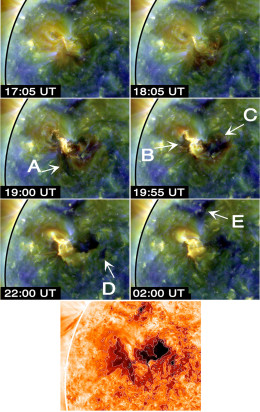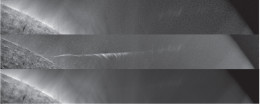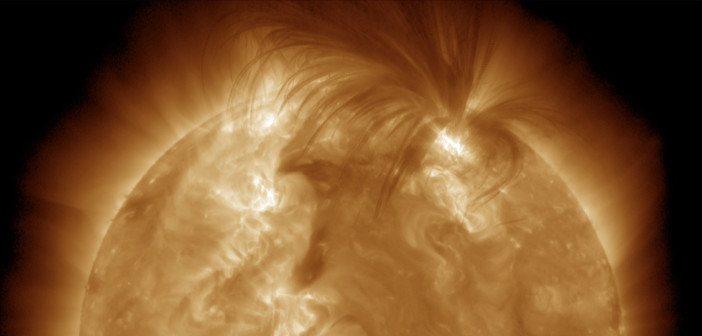
This time series of SDO images of an active region shows coronal dimming as well as flares. These images can be combined into a minimum-value persistence map (bottom panel) that better reveals the entire dimming region. [Adapted from Thompson & Young 2016]
Mapping Evolving Features
Sometimes interesting advances in astronomy come from simple, creative new approaches to analyzing old data. Such is the case in a new study by Barbara Thompson and Alex Young (NASA Goddard Space Flight Center), which introduces a technique called “persistence mapping” to better examine solar phenomena whose dynamic natures make them difficult to analyze.
What is a persistence map? Suppose you have a set of N images of the same spatial region, with each image taken at a different time. To create a persistence map of these images, you would combine this set of images by retaining only the most extreme (for example, the maximum) value for each pixel, throwing away the remaining N-1 values for each pixel.
Persistence mapping is especially useful for bringing out rare or intermittent phenomena — features that would often be washed out if the images were combined in a sum or average instead. Thompson and Young describe three example cases where persistence mapping brings something new to the table.

Top: Single SDO image of Comet Lovejoy. Center: 17 minutes of SDO images, combined in a persistence map. The structure of the tail is now clearly visible. Bottom: For comparison, the average pixel value for this sequence of images. Click for a closer look! [Thompson & Young 2016]
A Comet’s Tail
As Comet Lovejoy passed through the solar corona in 2011, solar physicists analyzed extreme ultraviolet images of its tail — because the motion of the tail particles reveals information about the local coronal magnetic field.
Past analyses have averaged or summed images of the comet in orbit to examine its tail. But a persistence map of the maximum pixel values far more clearly shows the striations within the tail that reveal the directions of the local magnetic field lines.
Dimming of the Sun
Dimming of the Sun’s corona near active regions tells us about the material that’s evacuated during coronal mass ejections. This process can be complex: regions dim at different times, and flares sometimes hide the dimming, making it difficult to observe. But understanding the entire dimming region is necessary to infer the total mass loss and complete magnetic footprint of a gradual eruption from the Sun’s surface.

SDO and STEREO-A images of a prominence eruption. Tracking the falling material is difficult due to the complex background. [Thompson & Young 2016]
An Erupting Prominence
The authors’ final example is of falling prominence material after a solar eruption, seen in absorption against the bright corona. They show that you can construct a persistence map of minimum pixel values over the time the material falls (see the cover image), allowing the material’s paths to be tracked despite the evolving background behind it. Tracing these trajectories provides information about the local magnetic field.
Thompson and Young’s examples indicate that persistence mapping clearly provides new information in some cases of intermittent or slowly evolving solar phenomena. It will be interesting to see where else this technique can be applied!
Citation
B. J. Thompson and C. A. Young 2016 ApJ 825 27. doi:10.3847/0004-637X/825/1/27

1 Comment
Pingback: Visualizar cambios solares « SEDA / LIADA